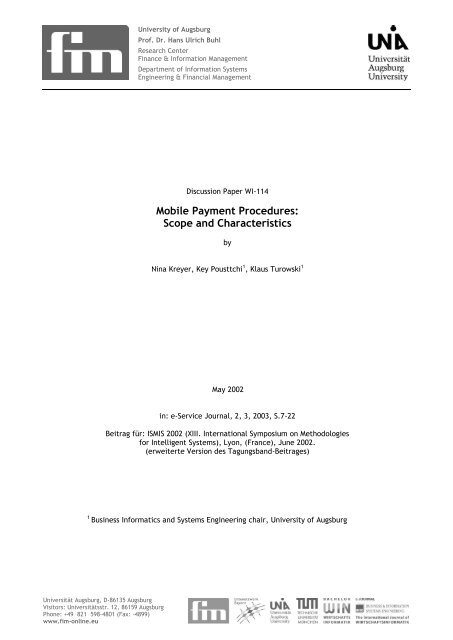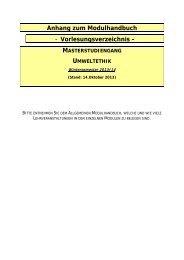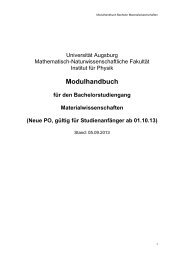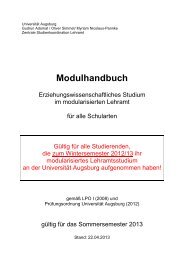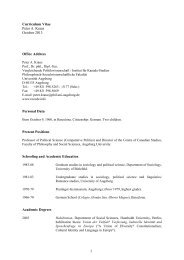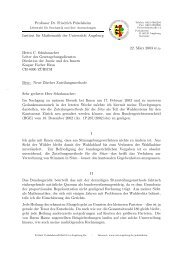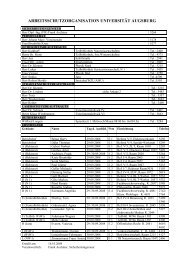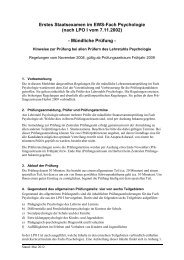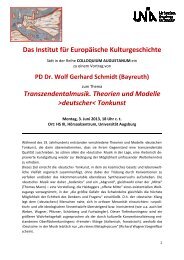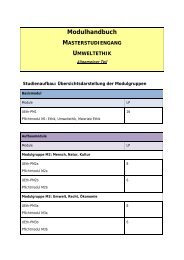Mobile Payment Procedures: Scope and Characteristics - Universität ...
Mobile Payment Procedures: Scope and Characteristics - Universität ...
Mobile Payment Procedures: Scope and Characteristics - Universität ...
You also want an ePaper? Increase the reach of your titles
YUMPU automatically turns print PDFs into web optimized ePapers that Google loves.
<strong>Universität</strong> Augsburg, D-86135 Augsburg<br />
Visitors: <strong>Universität</strong>sstr. 12, 86159 Augsburg<br />
Phone: +49 821 598-4801 (Fax: -4899)<br />
www.fim-online.eu<br />
University of Augsburg<br />
Prof. Dr. Hans Ulrich Buhl<br />
Research Center<br />
Finance & Information Management<br />
Department of Information Systems<br />
Engineering & Financial Management<br />
Discussion Paper WI-114<br />
<strong>Mobile</strong> <strong>Payment</strong> <strong>Procedures</strong>:<br />
<strong>Scope</strong> <strong>and</strong> <strong>Characteristics</strong><br />
by<br />
Nina Kreyer, Key Pousttchi 1 , Klaus Turowski 1<br />
May 2002<br />
in: e-Service Journal, 2, 3, 2003, S.7-22<br />
Beitrag für: ISMIS 2002 (XIII. International Symposium on Methodologies<br />
for Intelligent Systems), Lyon, (France), June 2002.<br />
(erweiterte Version des Tagungsb<strong>and</strong>-Beitrages)<br />
1 Business Informatics <strong>and</strong> Systems Engineering chair, University of Augsburg
MOBILE PAYMENT PROCEDURES:<br />
SCOPE AND CHARACTERISTICS*<br />
Authors:<br />
Nina Kreyer<br />
University of Augsburg<br />
Chair of Business Administration, Business Information Systems <strong>and</strong><br />
Financial Engineering<br />
Universitaetsstrasse 16<br />
86159 Augsburg, Germany<br />
phone: ++49 (0) 821 / 598 - 4138<br />
fax: ++49 (0) 821 / 598 – 4225<br />
email: nina.kreyer@wiwi.uni-augsburg.de<br />
Key Pousttchi<br />
University of Augsburg<br />
Chair of Business Information Systems <strong>and</strong> Systems Engineering (WI2)<br />
Universitaetsstrasse 16<br />
86159 Augsburg, Germany<br />
phone: ++49 (0) 821 / 598 - 4434<br />
fax: ++49 (0) 821 / 598 – 4432<br />
email: key.pousttchi@wiwi.uni-augsburg.de<br />
Prof. Dr. Klaus Turowski<br />
University of Augsburg<br />
Chair of Business Information Systems <strong>and</strong> Systems Engineering (WI2)<br />
Universitaetsstrasse 16<br />
86159 Augsburg, Germany<br />
phone: ++49 (0) 821 / 598 - 4431<br />
fax: ++49 (0) 821 / 598 – 4432<br />
email: klaus.turowski@wiwi.uni-augsburg.de<br />
* This research paper is based on Kreyer N.; Pousttchi, K.; Turowski, K.: <strong>Characteristics</strong> of <strong>Mobile</strong><br />
<strong>Payment</strong> <strong>Procedures</strong>. In: Maamar, Z.; Mansoor, W.; van den Heuvel, W.-J. (Eds.): Proceedings of the<br />
ISMIS 2002 Workshop on M-Services. Lyon 2002.
MOBILE PAYMENT PROCEDURES:<br />
SCOPE AND CHARACTERISTICS<br />
Abstract. The existence of st<strong>and</strong>ardized <strong>and</strong> widely accepted mobile payment procedures<br />
is crucial for successful business-to-customer mobile commerce. Customers’ acceptance<br />
of mobile payment (MP) procedures mainly depends on the issues of cost, security, <strong>and</strong><br />
convenience. In particular, it is important that a procedure can be used over a variety of<br />
payment scenarios such as mobile commerce, electronic commerce, stationary merchant,<br />
<strong>and</strong> customer-to-customer. Current payment procedures can be categorized by using<br />
strategic, participation <strong>and</strong> operational criteria, based on the morphological method. The<br />
scheme we propose allows us to unambiguously identify <strong>and</strong> characterize any given<br />
mobile payment procedure. The proposed scheme allows three basic types of<br />
applications: merchants <strong>and</strong> customers can analyze <strong>and</strong> represent their preferences for<br />
MP procedures in a structured way, (prospective) mobile payment service providers may<br />
analyze their market expectations <strong>and</strong> develop MP procedures according to these, <strong>and</strong><br />
different market participants may use it as a basis for st<strong>and</strong>ardization.<br />
Keywords. <strong>Mobile</strong> <strong>Payment</strong>, <strong>Mobile</strong> Commerce, <strong>Payment</strong> Scenarios, <strong>Mobile</strong> Added<br />
Values, St<strong>and</strong>ardization.<br />
2
1 Introduction<br />
The ever growing number of mobile phone users as a target group represents an<br />
enormous potential for mobile commerce (MC) as a new level of electronic commerce<br />
(EC). For the purpose of this paper, we define EC as any kind of business transaction, in<br />
the course of which transaction partners employ electronic means of communication, be it<br />
for initiation, arrangement, or realization of performance (ECOM 1998). We define MC<br />
as a subset of these, on the condition that at least one side uses mobile communication<br />
techniques.<br />
Currently, there are already 1.4 billion people using mobile phones (over 80% of them<br />
located in Asia, Western Europe <strong>and</strong> the US), <strong>and</strong> the numbers are expected to rise to<br />
over 2.3 billion in 2005 (Graumann <strong>and</strong> Koehne, 2002). This is especially interesting,<br />
since, in most countries, the penetration of mobile phones is growing even faster than the<br />
Internet. In Western Europe, over 64% of the population uses a mobile phone, while only<br />
35% use the Internet. (Note: In the US, 55% of the citizens have Internet access, while<br />
only 40% of the population uses a mobile phone.) According to recent studies, worldwide<br />
MC revenues are expected to rise from approximately 3.4 billion U.S. dollars in 2002 up<br />
to 22.2 billion U.S dollars in 2005 (Graumann <strong>and</strong> Koehne, 2002). However, so far, most<br />
mobile applications are still transformations of conventional Internet applications or EC<br />
business models for mobile devices. In order to be successful (<strong>and</strong> thus gain profits) in an<br />
MC setting, this is not sufficient. New business models <strong>and</strong> added values are necessary.<br />
Typical value-added features of MC originate from ubiquity, context-sensitivity,<br />
identifying functions, or comm<strong>and</strong> <strong>and</strong> control functions of MC applications (Pousttchi et<br />
3
al., 2003). In addition to technical issues, such as packet-oriented data transmission,<br />
adequate payment procedures are most important in realizing their potential. Since<br />
companies are not going to invest in the development of innovative MC applications or<br />
services unless they can be charged for appropriately, the existence of st<strong>and</strong>ardized <strong>and</strong><br />
widely accepted mobile payment (MP) procedures is crucial.<br />
Because this is especially true for business-to-customer (B2C) MC, we focus on B2C MP<br />
in this paper. The conditions for implementing easy-to-use MP procedures on the<br />
customers’ side are good. As a study by Accenture reveals, more than 30% of<br />
interviewed customers would like to use their mobile phone as a wallet (Graumann <strong>and</strong><br />
Koehne, 2002). Therefore, a mobile payment function provides an added value for the<br />
customer – even more value if it enables customer-to-customer (C2C) transactions <strong>and</strong><br />
thus, an incentive to use <strong>and</strong> spread an MP procedure. Therefore, in this paper, we will<br />
examine C2C MP along with B2C MP. We do not question the justifiability of research<br />
focused on B2C issues <strong>and</strong> underline the importance of industry research in this field.<br />
However, a general MP definition not considering C2C MP (e.g., in <strong>Mobile</strong> <strong>Payment</strong><br />
Forum 2002) seems too narrow.<br />
Thus, for our purposes, we define mobile payment as a subset of MC focusing on the<br />
completion of payment. We focus, therefore, not on technical issues (as several industry<br />
consortia, e.g., Paycircle or the <strong>Mobile</strong> <strong>Payment</strong> Forum) or the clearing process, but on<br />
the payment interface to the customer. As will be shown later, MP is crucial for, but not<br />
limited to MC scenarios. On the contrary, usability of an MP procedure in scenarios other<br />
than MC is relevant for its acceptance.<br />
After we reflect on the issue of acceptance, we identify, classify, <strong>and</strong> aggregate<br />
4
characteristics of MP procedures within a morphological box (Zwicky, 1966). This<br />
allows us to distinguish actual <strong>and</strong> foreseeable types of MP procedures more precisely.<br />
Finally, we address the issue of st<strong>and</strong>ardization <strong>and</strong> discuss possible applications of the<br />
scheme for relevant market participants.<br />
Please note that our discussion of a general payment method, such as credit card usage,<br />
electronic payment, or MP, refers to the term payment systems. When we talk about<br />
concrete solutions such as Paypal, we use the term payment procedures.<br />
2.1 General acceptance<br />
2 Acceptance of MP<br />
An examination of the development of payment procedures shows that the key to<br />
acceptance is in the h<strong>and</strong>s of customers. Two well-known examples are the spread of the<br />
US credit card system in Europe (although merchants were not enthusiastic about<br />
h<strong>and</strong>ing over 3 to 5 percent of their revenue to credit card issuers) <strong>and</strong> the simple debit<br />
procedure in Germany (although banks tried hard to prevent this in favor of selling their<br />
point-of-sale terminals to merchants). These systems finally superseded the Eurocheque,<br />
which dominated the market for many years, because of the market power of customers<br />
who wanted to use them, regardless of the preferences of banks or merchants.<br />
In the course of a study on mobile banking (Speedfacts Online Research, 2001), more<br />
than 16,000 Internet users were interviewed about their payment preferences. On the<br />
issue of general acceptance, about two-thirds stated that they would definitely pay, or<br />
would consider paying, using their mobile phones. The most significant acceptance was<br />
5
from people already using electronic banking. On the issue of preferred payment systems,<br />
the mobile phone would be preferred by about a quarter of the interviewees for<br />
micropayments (less than 2.50 €), a third for macropayments from 2.50 € up to 50 €, a<br />
fifth for macropayments up to 250 €, <strong>and</strong> by 13% for amounts over 250 €. In the segment<br />
between 12.50 € <strong>and</strong> 50 €, paying by mobile phone would be the most preferred method<br />
(Fig. 1).<br />
< 2,5 €<br />
2,5 - 12,5 €<br />
12,5 - 50 €<br />
50 - 250 €<br />
> 250 €<br />
24,8%<br />
19,0%<br />
13,0%<br />
32,3%<br />
37,1%<br />
0% 10% 20% 30% 40% 50% 60% 70% 80%<br />
6<br />
Cash<br />
Debit-/Credit Card<br />
<strong>Mobile</strong> Phone<br />
Fig. 1: Preferred payment methods of mobile Internet users (Speedfacts Online Research 2001)<br />
These results show that general preconditions are favorable for customer acceptance of<br />
MP. However, we believe that the decisive factor for a market breakthrough is the<br />
acceptance <strong>and</strong> actual use of concrete MP procedures. This represents a major failure risk<br />
in the transformation of general MP acceptance into concrete acceptance <strong>and</strong> use.<br />
2.2 Acceptance of individual payment procedures<br />
If the key to acceptance of MP is in the h<strong>and</strong>s of customers, this leads to the question of<br />
determinants influencing the acceptance of a single MP procedure. Furthermore, other<br />
participants (in particular, merchants) will only be able to follow customer preferences up<br />
to a defined point, where disadvantages begin to outweigh the advantages.
While the issue of acceptance has had a significant amount of discussion in the literature,<br />
(e.g. Cheong, 2001; Kruppa, 2001; <strong>and</strong> Robben 2001), most arguments can be subsumed<br />
into three categories:<br />
• Cost – which includes direct transaction costs <strong>and</strong> fixed costs of usage, plus<br />
the cost of the technical infrastructure for the customer (e.g., a new mobile<br />
phone) <strong>and</strong> the merchant (e.g., the integration of the payment solution into the<br />
existing IT infrastructure).<br />
• Security – which includes not only integrity, authorization, authentication,<br />
confidentiality, <strong>and</strong> non-repudiation of transactions, but also the issue of<br />
subjective security from the customer’s perspective.<br />
• Convenience – which includes ease <strong>and</strong> comfort of use, as well as the<br />
attainment of concrete benefits from use.<br />
For the latter, it is important that a procedure is not limited to MC scenarios, but can be<br />
used in other settings, as well. That is, it should be possible to use the procedure<br />
whenever, wherever, <strong>and</strong> for whatever kind of payment the user desires.<br />
2.3 Relevant payment scenarios<br />
We already claimed that MP is not limited to MC. Instead, a mobile payment transaction<br />
can take place in different settings.<br />
Brokat defines three “worlds” for transactions -- the “r-world”, “e-world”, <strong>and</strong> “m-world”<br />
(Kruppa, 2001). We agree with this distinction regarding the point of sale (or service), but<br />
we will differentiate among them a little more precisely <strong>and</strong>, for the reasons mentioned in<br />
section 1, add the idea of payments from one customer to another. This leads us to four<br />
7
general MP scenarios: the mobile commerce scenario, the electronic commerce scenario,<br />
the stationary merchant scenario, which can occur as stationary merchant scenario<br />
(person) <strong>and</strong> stationary merchant scenario (automat), <strong>and</strong> the customer-to-customer<br />
scenario. We also note that in different settings, MP competes with a variety of other<br />
payment systems, being a unique proposition only in MC (Table 1).<br />
Table 1: Relevant MP scenarios<br />
Scenario Scenario Description Competing payment<br />
MC<br />
scenario<br />
EC<br />
scenario<br />
Stationary merchant<br />
scenario<br />
(person)<br />
(automat)<br />
C2C<br />
scenario<br />
New applications <strong>and</strong> services (e.g., contextsensitive<br />
information or video/audio streaming on<br />
mobile devices)<br />
All kinds of B2C EC excluding MC (e.g., purchase<br />
of goods or content via the Internet)<br />
"Brick-<strong>and</strong>-mortar" commerce with transactions<br />
between a person (customer) <strong>and</strong>:<br />
- a person (e.g., cashier) respectively<br />
- a vending machine.<br />
Money transfers between individuals (e.g., pocketmoney<br />
for children, settling debts for small<br />
amounts)<br />
8<br />
- - -<br />
Offline<br />
Debit-/Credit Card<br />
e-payment<br />
Cash<br />
Debit-/Credit Card<br />
(Cash)<br />
(Offline)<br />
For a focus on technical issues (e.g., protocol development), it is often useful to define<br />
basic scenarios with regard to the type of goods or services delivered instead of the point<br />
of sale. A good example is provided in Paycircle, 2002. For our focus, this is only one<br />
characteristic that we will examine along with the payment frequency in section 3.<br />
The distinction of the scenarios is not only important for the examination of the different<br />
payment procedures to be discussed in section 4, but also for a brief look at the strategy<br />
of market entry <strong>and</strong> its effects on the development of payment procedures.<br />
We stated in section 1, that MP is crucial for, but not limited to MC scenarios. In any<br />
payment scenario, there is at least some MP procedure that makes sense; most MP<br />
procedures are usable in more than one payment scenario (Kreyer et al., 2002).
Before we discuss these payment scenarios, it is useful to reflect briefly on the relevance<br />
of usability in each scenario as it affects the acceptance <strong>and</strong> diffusion of the procedure.<br />
Figure 2 shows the acceptance of MP by customers in the different payment scenarios as<br />
derived from an empirical study on the German market (Khodaw<strong>and</strong>i et al., 2003).<br />
• <strong>Mobile</strong> commerce scenario. On the one h<strong>and</strong>, as we stated above, MP allows the<br />
potential of mobile commerce to unfold. Our recent study in Germany, Europe's<br />
biggest market for cellular phone networks, showed that 80.3% of customers who<br />
intend to use MP answered that they will use it in the MC scenario (Figure 2).<br />
However, MC itself has represented only low revenue rates up to now, <strong>and</strong> it is<br />
questionable if customers will accept an MP procedure just for the possibility of<br />
using it occasionally in a MC setting. The dilemma could arise that nobody uses an<br />
MP procedure because it is limited to MC, <strong>and</strong> nobody uses MC because there is no<br />
widely accepted MP procedure.<br />
• Electronic commerce scenario. In opposition to MC, EC has already demonstrated<br />
good revenue potential. However, in the view of merchants, the payment problem<br />
still remains unsolved, <strong>and</strong> payments for most transactions are conducted through<br />
offline methods (e.g., Robben, 2001), with obvious disadvantages. Additionally, the<br />
target group of EC users could be very interested in (<strong>and</strong> interesting for) MP. For<br />
these reasons, one might assume that the EC scenario would be of high relevance.<br />
However, as we see in Figure 2, this appears not to be the case. Furthermore, the<br />
study showed 41% of customers explicitly disapproving of the use of MP in the EC<br />
scenario. An explanation may be that from the customer’s viewpoint the payment<br />
problem in EC is solved. However, this point is still subject to closer examination.<br />
9
• Stationary merchant scenario. The revenue potential of the stationary merchant<br />
scenario is definitely the highest of the four scenarios. However, it remains uncertain<br />
not only as to whether the average mobile phone user is the right target group for a<br />
pioneer application like MP, but also as to whether it will be possible to convince<br />
traditional merchants to accept a payment procedure prior to having a significant<br />
number of regular MP users. In any case, Figure 2 shows that customers express a<br />
substantial dem<strong>and</strong> for MP usage in this scenario, especially when it comes to<br />
vending machines of all types (e.g., ticket machines, cigarette automats, parking<br />
ticket machines).<br />
• Customer-to-customer scenario. The opportunity to transfer money from customer<br />
to customer represents the least incentive for the use of an MP procedure. Although<br />
for special target groups (e.g., young people) C2C MP may be the main reason to use<br />
an MP procedure. This is unlikely for the average user.<br />
MC<br />
Stat ionary merchant<br />
(automat)<br />
Stat ionary merchant<br />
(person)<br />
EC<br />
C2C<br />
13 ,7%<br />
22,4%<br />
27,1%<br />
10<br />
40,8%<br />
80,3%<br />
0% 20% 40% 60% 80% 100%<br />
Fig. 2: Acceptance of MP in the payment scenarios (Khodaw<strong>and</strong>i et al., 2003)<br />
After determining <strong>and</strong> examining the general payment scenarios <strong>and</strong> the relevance of<br />
each of these for the development of MP procedures, we will now develop a classification
scheme identifying other relevant characteristics of MP procedures.<br />
3.1 General remarks<br />
3 Typical <strong>Characteristics</strong> of MP <strong>Procedures</strong><br />
Currently various MP procedures are emerging in the MC market. (For an overview see<br />
Henkel, 2002.) As shown in section 1, MP procedures appear to play a major role in the<br />
diffusion of MC. Credit card issuers, as well as financial services providers or start up<br />
companies, are realizing its potential <strong>and</strong> are trying to establish their payment procedures<br />
in order to gain further revenues from customers <strong>and</strong>/or merchants.<br />
In order to decide weather or not these procedures are actually diverse (other than their<br />
labeling), <strong>and</strong> what criteria differentiate them from one another, a closer examination of<br />
MP procedures is necessary. First, this analysis will establish a common framework in<br />
order to define <strong>and</strong> distinguish the different technical terms related to MP. This will allow<br />
us to unambiguously identify any given MP procedure. The procedures can then be<br />
compared <strong>and</strong> their relevant characteristics identified. This will be helpful for further<br />
research, since it allows us to rate MP procedures according to their chances of success,<br />
reveal their limitations, <strong>and</strong> thus provide recommendations for MP service providers as<br />
well as for other MP stakeholders (e.g., customers or merchants).<br />
Within this paper, we focus on three main issues relevant to MP procedures. First there<br />
are characteristics that concern the general positioning of a MP procedure within a given<br />
market. Second, we discuss issues concerning the participating parties, especially<br />
focusing on MP users’ interests. Finally we consider MP-inherent, operational topics.<br />
11
In conducting our analysis, we use the morphological method according to Zwicky, 1966.<br />
This method allows us to fractionalize any given problem into its multi-dimensional<br />
aspects <strong>and</strong> to identify the various instances of each aspect. The aspects <strong>and</strong> their<br />
instances can then – as is a key element within the morphological method – easily be<br />
summarized <strong>and</strong> visualized in a table, the so called morphological box. When applying<br />
the morphological method to given MP procedures we are, through the combination of<br />
the aspects <strong>and</strong> instances, able to structure MP procedures <strong>and</strong> identify common<br />
characteristics, as well as major differences. Furthermore, we can identify missing<br />
elements <strong>and</strong> are able to propose improvements as well as new solutions. The following<br />
sections will give an overview of the analysis <strong>and</strong> present our results in a morphological<br />
box. To facilitate quick underst<strong>and</strong>ing, the aspects as well as the instances are written in<br />
italics.<br />
3.2 Strategic Questions<br />
First we have to analyze the suitability of a given payment method for the identified<br />
payment scenarios. The relevance of these different scenarios has already been discussed<br />
in section 2.3. It is now necessary to examine whether the different payment procedures<br />
will actually work within the described scenarios of MC, EC, stationary merchant<br />
(person as well as machine), <strong>and</strong> C2C (Figure 3).<br />
payment<br />
scenarios<br />
MC EC<br />
stationary merchant<br />
(person)<br />
12<br />
stationary merchant<br />
(automat)<br />
Fig. 3: Characteristic “suitability for different payment scenarios”<br />
Another crucial question is, whether the selected payment model is suitable for various<br />
C2C
invoice amounts (payment levels, Figure 4). In the US, 40% of online merchants want to<br />
offer items costing less than $10, but transaction fees of most payment procedures do not<br />
make this cost-effective (Sutherl<strong>and</strong> 2003). <strong>Payment</strong> categories are usually differentiated<br />
in picopayments (which we define as amounts of 10 cents or less, down to fractions of a<br />
cent), micropayments (amounts larger than 10 cents up to $5), lower (amounts from<br />
greater than $5 to $50) <strong>and</strong> higher macropayments (amounts higher than $50) (section 2<br />
<strong>and</strong> (Kieser 2001)). While within the category of macropayments transaction costs can<br />
usually be neglected, they are critical when it comes to pico- or micropayments, since<br />
they may be greater than the total revenue made with the service. An MP procedure may,<br />
therefore, be considered a reasonable means of payment, as long as the payment amount<br />
is larger than its total transaction costs.<br />
payment levels<br />
3.3 Participants<br />
picopayments<br />
(≤ 10 cents)<br />
micropayments<br />
(> 10 cents to $5)<br />
Fig. 4: Characteristic “payment heights”<br />
macropayments<br />
(> $5 to $50)<br />
macropayments<br />
( > $50)<br />
3.3.1 General Participants: Since many different parties can be involved within a<br />
payment process, their roles <strong>and</strong> objectives have to be considered. The integration of a<br />
large number of different stakeholders leads to high complexity <strong>and</strong> difficult negotiations<br />
(e.g., concerning the sharing of revenues or payment risks). Besides the customers <strong>and</strong><br />
merchants who trade (electronic or physical) goods or services <strong>and</strong> use an MP procedure<br />
for settlement, there are other relevant parties involved in the payment process.<br />
Therefore, we examine first which parties may serve as a payment service provider<br />
(Figure 5). <strong>Mobile</strong> network operators (MNO) usually operate the technical infrastructure<br />
13
<strong>and</strong> can be involved in the payment process, as well (e.g., when they offer billing services<br />
for third parties). However, they may also operate an MP procedure themselves <strong>and</strong><br />
provide payment services for customers <strong>and</strong> merchants. Banks or financial service<br />
providers (FSPs) (e.g., credit card companies) may be involved as a clearing/settlement<br />
instance, or they may offer their own MP procedures for their customers. Since they<br />
usually have good reputations, they may also be involved as a trusted third party. Both –<br />
MNO as well as banks or FSP – already have access to their customers <strong>and</strong> are<br />
accustomed to dealing with financial issues. Another group of payment service providers<br />
are newly founded, specialized intermediaries whose core business <strong>and</strong> competency is to<br />
operate MP procedures. Finally, there is a group that we refer to as others. These usually<br />
are old economy companies who develop efficient payment procedures integrated into<br />
their own business. One example is the Austrian Railway Company, which offers a<br />
mobile payment procedure for its train-ticketing.<br />
payment service<br />
provider<br />
MNO bank/FSP spec. intermediary others<br />
Fig. 5: Characteristic “payment service provider”<br />
Besides identifying the different participants, the question of who receives customers’<br />
data (receiver of customer’s data) is important (Figure 6). On the one h<strong>and</strong>, customers are<br />
rarely willing to spread their personal data among various institutions or intermediaries.<br />
On the other h<strong>and</strong>, gaining information about customers is one of the most relevant issues<br />
for merchants <strong>and</strong>/or providers in today’s business. Parties, who receive customer data,<br />
may be – besides the payment service provider – MNO (e.g., when h<strong>and</strong>ling the billing<br />
process) banks/FSP, <strong>and</strong>/or merchants (e.g., as an incentive to accept a given MP<br />
14
procedure). However, within MP procedures, it is also possible that nobody receives the<br />
customer's data (this is typical when paying with a prepaid card for a certain service or<br />
buying goods with digital cash anonymously). We also need to mention that MNO,<br />
bank/FSP or even the merchant may be identical to the payment service provider <strong>and</strong><br />
receive data on this account.<br />
receiver of<br />
customer data<br />
payment service<br />
provider<br />
MNO bank/FSP merchant nobody<br />
Fig. 6: Characteristic “receiver of customers’ data”<br />
3.3.2 Customers: Having discussed the relevant stakeholders <strong>and</strong> their interests, we now<br />
take a closer look at customers, since they are the key for MP acceptance. One way to<br />
classify MP procedures is based on the need for pre-registration through the customer<br />
(Figure 7). Besides a difference in convenience, the need for anonymity can be the<br />
deciding factor regarding an offered solution. If customers have to register, they have to<br />
transfer personal data to some other institution <strong>and</strong> may feel as if they are being<br />
monitored. Therefore, they may favor payment solutions such as prepaid cards that allow<br />
them to remain anonymous (i.e., depending on the purchased products, the payment<br />
levels, or security issues).<br />
pre-registration<br />
needed?<br />
yes no<br />
Fig. 7: Characteristic “pre-registration”<br />
Another important issue influencing both convenience <strong>and</strong> the establishment of MP<br />
procedures is the technical infrastructure needed on the customers’ side (technology<br />
15
equired) in order to participate within a certain payment procedure (Figure 8). As<br />
evidenced by SET (Secure Electronic Transactions), a highly-sophisticated technology<br />
may be objectively very secure <strong>and</strong> advanced, but it will probably fail if it is difficult to<br />
use, or is not widespread. While some MP procedures are based on voice messaging only,<br />
a large number of MP procedures are based on simple text-message exchange or Wireless<br />
Application Protocol (WAP), which requires Internet-enabled phones.<br />
Besides the necessity to transfer data via one of the above-mentioned st<strong>and</strong>ards, some MP<br />
services, in addition, require dual-slot or dual-chip-phones on the customers’ side. Dual-<br />
slot-phone-technologies use the regular SIM-card (subscriber identification module card)<br />
to identify the mobile device <strong>and</strong> also provide a second card-slot (e.g., for a credit- or<br />
debit card integrated within the mobile phone). When paying for a service or product, the<br />
user is asked to insert his credit or debit card into this second slot <strong>and</strong> to authenticate<br />
himself (e.g., via a Personal Identification Number (PIN)). The phone then serves as a<br />
regular payment terminal, similar to the ones already used with stationary merchants. One<br />
of the few existing dual-slot payment systems, ItiAchat, has been initiated by France<br />
Telecom <strong>and</strong> the Groupement des Cartes Bancaires. The procedure allows one to conduct<br />
payments within the EC, MC, <strong>and</strong> stationary merchant payment scenarios.<br />
Dual-SIM-technologies operate similar to this method, only the second card (a credit or<br />
debit card the size of a SIM-card) is already integrated in the mobile device – an extra<br />
slot is not needed, <strong>and</strong>, therefore, some of the shortcomings of the dual-slot technology<br />
(e.g., usually heavier, more bulky devices) are overcome. The Electronic <strong>Mobile</strong> <strong>Payment</strong><br />
Services (EMPS) may serve as an example for this <strong>Payment</strong> type. Since it is still in its<br />
pilot-phase, so far it can only be used in an EC scenario (www.ruoka.net) or with a<br />
16
stationary merchant (the movie theatre “kinopalatsi”), but may as well be used within the<br />
MC scenario.<br />
Another application used within some payment models is a special payment software<br />
needed on the customer side (e.g., a software on the mobile device which generates<br />
digital coins or identifies the user when paying via the mobile phone).<br />
technology<br />
required<br />
3.4 Operational Issues<br />
text-message exchange internet enabled phone dual-slot/dual-card phone special payment software<br />
Fig. 8: Characteristic “technology required on the customers’ side”<br />
After discussing the issues concerning the different stakeholders of MP procedures, we<br />
will now focus on criteria that allow us to distinguish MP services according to their<br />
functions.<br />
Any given MP procedure can be distinguished according to its basis of payment (Figure<br />
9), which can either be token- or account-based (Cheong, 2001). Token-based payment<br />
procedures use tokens to represent monetary value (e.g., when payment software<br />
generates digital cash (“electronic coins”) on a mobile device). The tokens are exchanged<br />
during the financial transaction, <strong>and</strong> the customer usually needs to create virtual money<br />
(e.g., with a certain software) <strong>and</strong> store it on the mobile device. Token-based MP<br />
procedures usually allow the user to remain anonymous when paying <strong>and</strong> also permit<br />
pico- or micropayments, since the tokens can be created in any given fraction of “real”<br />
money. However, most MP procedures are account-based. The user needs to register with<br />
the payment provider, <strong>and</strong> all payments are settled via his account.<br />
17
asis of<br />
payment<br />
token-based account-based<br />
Fig. 9: Characteristic “basis of payment”<br />
The suitability of an MP procedure for various payment frequencies is another important<br />
factor concerning the establishment of MP procedures (Figure 10). When paying per time<br />
unit, the customer is charged for the time he has used a certain service (e.g., playing a<br />
game or sending data). However, payments per product unit is probably the most frequent<br />
payment method. With this method, an event-based fee is charged (e.g., for the download<br />
of an MP3 file or the purchase of a book) regardless of the time used to purchase it. A<br />
third payment method can be the subscription of goods or services. The subscription of<br />
services may be limited to a certain number of uses (e.g., the use of an information<br />
service twice a month), certain volumes of a product (e.g., brokerage information of<br />
selected shares once a day), or one may use the service without any limitations (e.g.,<br />
when subscribing to a database).<br />
payment<br />
frequency<br />
pay per time unit pay per product unit subscription / st<strong>and</strong>ing order<br />
Fig. 10: Characteristic “payment frequency”<br />
Focusing on the time of account settlement (deduction time), there are different methods<br />
for charging services or goods to the customer. Those methods can be differentiated<br />
according to the time the payment is actually settled (Figure 11). First, there are prepaid<br />
methods. The customer either buys a smart-card, where the money-value is stored, <strong>and</strong><br />
then pays off of this credit for goods or services desired, or he can upload a digital wallet<br />
with electronic coins on a prepaid basis. Subscription of special services can be another<br />
18
prepaid method in which one pays for something first <strong>and</strong> receives the service later at a<br />
specific point in time. All of these prepaid services usually allow anonymity on the<br />
customer's side <strong>and</strong> are already used for EC payments. Another category of account<br />
settlements is instant-paid methods. These payments are triggered as soon as the<br />
customer accepts the offer. An example of this payment method is direct debiting systems<br />
such as the “Maestro” debit card or the French “Carte Bancaire”. Debit cards have – in<br />
Europe <strong>and</strong> North America – a high penetration rate among the population <strong>and</strong> are widely<br />
accepted within traditional shops as well as in EC payment scenarios. They are easy to<br />
use, <strong>and</strong> all that is needed for the customer is a checking account at the bank issuing the<br />
card. A third method of charging for goods or services involves so called post-paid<br />
services. The customer purchases a product or service <strong>and</strong> is charged for it later. Typical<br />
examples are so called “offline-methods” such as “collect on delivery” or invoices.<br />
Credit-card payments or payments via the phone bill are other typical post-paid payment<br />
methods. These are typically used in traditional payment scenarios such as for stationary<br />
merchants or for catalog shopping. They are also widespread <strong>and</strong> generally accepted.<br />
deduction time prepaid instant-paid post-paid<br />
Fig. 11: Characteristic “deduction time”<br />
Besides the actual settlement time, the number of offered payment methods that can be<br />
used for the settlement (method for settlement) is relevant (Figure 12). Since the customer<br />
is already used to having different choices of how to pay for a purchased good <strong>and</strong> is<br />
likely to chose a new payment method only if it allows him to use his accustomed<br />
payment practices, the number of different payment methods offered by the provider to<br />
19
settle payments will contribute to the acceptance of the payment method itself. As<br />
mentioned above, typical settlement methods include payments via smart or prepaid-<br />
cards as well as innovative instruments such as electronic cash or digital wallets. Most<br />
MP-users, nevertheless, prefer “traditional” means of settlement, such as direct debiting –<br />
which is especially popular in Europe – or offline payments (e.g., via invoices). Credit<br />
cards are another popular method to settle payments. In some countries (especially Japan)<br />
it is also very common (<strong>and</strong> allowed) to settle debts via the telephone bill.<br />
method for<br />
settlement<br />
smart cards/<br />
prepaid cards<br />
electronic cash/<br />
digital wallet<br />
direct debiting offline payment credit card telephone bill<br />
Fig 12: Characteristic “method used for settlement”<br />
20
3.5 Morphological Box of MP <strong>Characteristics</strong> <strong>and</strong> Instances<br />
Based on the discussion in the sections above, the main characteristics of MP procedures<br />
<strong>and</strong> their instances can be summarized in Table 2.<br />
Table 2: Morphological box of MP characteristics <strong>and</strong> instances<br />
Characteristic instances<br />
strategic<br />
Participants<br />
operational<br />
payment<br />
scenarios<br />
payment levels<br />
payment service<br />
provider<br />
receiver of<br />
customer data<br />
pre-registration<br />
needed?<br />
technology<br />
required<br />
basis of<br />
payment<br />
payment<br />
frequency<br />
MC EC<br />
picopayments<br />
(≤ 10 cents)<br />
payment service<br />
provider<br />
micropayments<br />
(> 10 cents to $5)<br />
stationary merchant<br />
(person)<br />
21<br />
stationary merchant<br />
(automat)<br />
macropayments<br />
(> $5 to $50)<br />
C2C<br />
macropayments<br />
( > $50)<br />
MNO bank/FSP spec. intermediary others<br />
mobile network<br />
operator<br />
Bank/FSP merchant nobody<br />
yes no<br />
text-message exchange internet enabled phone dual-slot/dual-card phone<br />
token-based account-based<br />
special payment<br />
software<br />
pay per time unit pay per product unit subscription / st<strong>and</strong>ing order<br />
deduction time prepaid instant-paid post-paid<br />
method for<br />
settlement<br />
smart cards/<br />
prepaid cards<br />
electronic cash/<br />
digital wallet<br />
direct debiting offline payment credit card telephone bill<br />
As mentioned previously, use of the morphological method now allows us to analyze any<br />
given payment procedure according to these criteria. Various examples are shown in<br />
(Kreyer et al., 2002).<br />
4 Conclusions<br />
The outcome of this paper is an analysis of the scenarios in mobile payment <strong>and</strong> of the<br />
main characteristics of mobile payment procedures. The proposed scheme allows
primarily three types of applications: i) merchants <strong>and</strong> customers can analyze <strong>and</strong><br />
represent their preferences for MP procedures in a structured way, ii) mobile payment<br />
service providers may analyze their market expectations <strong>and</strong> develop MP procedures<br />
according to these, <strong>and</strong>, iii) different market participants may use it as a basis for<br />
st<strong>and</strong>ardization on one, some, or all of the criteria.<br />
An example for the first type of application, as well as an extension in the direction of the<br />
customer's view, is provided in Pousttchi et al., 2002, which also served as a basis for the<br />
empirical results in Khodaw<strong>and</strong>i et al., 2003.<br />
The second type of application points to a strategy of MP market entry. In order to do<br />
this, we have to put the scenarios in an order of relevance with regard to the intended use<br />
of the procedure. The procedure should, then, be developed with special regard to the<br />
most important scenarios. This prioritization could well be different for the different<br />
types of market participants who may want to act as mobile payment service providers.<br />
For an MNO the most important scenario will, of course, be MC. Since banks/FSP up to<br />
now have not been very interested in micropayments, this may be the stationary merchant<br />
scenario for them instead. However, the top-up (which is the international technical term<br />
for recharging mobile subscribers’ prepaid account) via MP seems to be extremely<br />
tempting for a collaborative solution between a bank/FSP <strong>and</strong> an MNO; respective<br />
solutions based on direct debit with online credit assessment exist (e.g., in the<br />
Netherl<strong>and</strong>s <strong>and</strong> in Belgium).<br />
The need for MP exists. Two notable examples of strong interest are from e-Bay, which<br />
even bought the specialized intermediary Paypal primarily for processing the C2C<br />
transactions between e-Bay customers (as this is crucial for its core business), or vending<br />
22
machine operators seeing the chance for dramatic cost reduction through the use of<br />
mobile technology.<br />
As a number of studies show, many customers would like to make payments using their<br />
mobile phones. However, since st<strong>and</strong>ardized MP procedures (or at least st<strong>and</strong>ardized<br />
interfaces) have not yet evolved, customers are not able to use one MP procedure at<br />
numerous merchants, <strong>and</strong> merchants are not able to address all mobile phone users<br />
offering a st<strong>and</strong>ardized MP procedure. This situation only leads to disappointed<br />
customers who adapt to the new technology very slowly, or may neglect it entirely. The<br />
problem has proven to be a major obstacle in the development of MC.<br />
Ways to attain st<strong>and</strong>ardization could be through a decreed global st<strong>and</strong>ard (e.g., the<br />
EDIFACT st<strong>and</strong>ard for electronic data interchange by the United Nations) or a<br />
proprietary st<strong>and</strong>ard (e.g., Microsoft Windows). Although we see efforts in the direction<br />
of several technical st<strong>and</strong>ards below the procedural level (e.g., the Java <strong>and</strong> XML<br />
payment st<strong>and</strong>ards proposed by Paycircle), this solution seems to be a distant prospect.<br />
An alternative approach could be the development of an integrative universal mobile<br />
payment system (UMPS) based on an abstraction layer above the procedural level. This<br />
UMPS would have to be user-centered <strong>and</strong> allow us to use any given payment procedure<br />
on any given mobile device <strong>and</strong> network with any given merchant <strong>and</strong> financial service<br />
provider interface. A reasonable solution would allow maintaining the variety of existing<br />
MP procedures <strong>and</strong> the variety of mobile devices. At the same time, customers as well as<br />
merchants could be relieved of the need to occupy themselves with the payment problem<br />
for mobile solutions.<br />
23
References<br />
Buhan, D., Cheong, Y.C., <strong>and</strong> Tan, C.-L. <strong>Payment</strong>s in <strong>Mobile</strong> Commerce, Telecom<br />
Media Networks, Paris, 2002.<br />
European Commission Electronic Commerce - An Introduction, Electronic Commerce<br />
<strong>and</strong> the European Union, Brussels, 1998.<br />
Graumann, S., <strong>and</strong> Koehne, B. Monitoring Information Age Society, 5th Report, NFO<br />
Infratest GmbH, Munich, 2002.<br />
Henkel, J. “<strong>Mobile</strong> <strong>Payment</strong>“ in <strong>Mobile</strong> Commerce, G. Silberer <strong>and</strong> J. Wohlfahrt <strong>and</strong> T.<br />
Wilhelm (eds.), Wiesbaden, 2002, pp. 327-351.<br />
Khodaw<strong>and</strong>i, D., Pousttchi, K., <strong>and</strong> Wiedemann, D. G. “Acceptance of <strong>Mobile</strong> <strong>Payment</strong><br />
<strong>Procedures</strong> in Germany,” in: <strong>Mobile</strong> Commerce - Applications <strong>and</strong> Perspectives.<br />
Proceedings of the 3rd Workshop on <strong>Mobile</strong> Commerce, K. Pousttchi <strong>and</strong> K. Turowski<br />
(eds.), Augsburg, 2003, pp. 42-57.<br />
Kieser, M. “<strong>Mobile</strong> <strong>Payment</strong> – Comparison of Electronic <strong>Payment</strong> <strong>Procedures</strong>,” in<br />
<strong>Mobile</strong> Commerce, A. Meier (ed.), Heidelberg, 2001, pp. 27-36.<br />
Kreyer N., Pousttchi, K., <strong>and</strong> Turowski, K. “<strong>Characteristics</strong> of <strong>Mobile</strong> <strong>Payment</strong><br />
<strong>Procedures</strong>,” in Proceedings of the ISMIS 2002 Workshop on M-Services, Z. Maamar, W.<br />
Mansoor <strong>and</strong> W.-J. van den Heuvel (eds.), Lyon, 2002, pp. 10-22.<br />
Kreyer, N., Pousttchi, K., <strong>and</strong> Turowski, K. “St<strong>and</strong>ardized <strong>Payment</strong> <strong>Procedures</strong> as Key<br />
Enabling Factor for <strong>Mobile</strong> Commerce,” in E-Commerce <strong>and</strong> Web Technologies, K.<br />
Bauknecht, G. Quirchmayr <strong>and</strong> A.M. Tjoa (eds.), Springer Lecture Notes in Computer<br />
Science, Aix-en-Provence, 2002, pp. 400–409.<br />
Kruppa, S. <strong>Mobile</strong> <strong>Payment</strong>. Beyond the M-Commerce Hype, Stuttgart, 2001.<br />
<strong>Mobile</strong> <strong>Payment</strong> Forum Enabling Secure, Interoperable <strong>and</strong> User-friendly <strong>Mobile</strong><br />
<strong>Payment</strong>s, White Paper, Wakefield, 2002.<br />
PayCircle PayCircle Scenarios, White Paper, Munich, 2002.<br />
Pousttchi, K. “Conditions for Acceptance <strong>and</strong> Usage of <strong>Mobile</strong> <strong>Payment</strong> <strong>Procedures</strong>,” in<br />
Proceedings of the Second International Conference on <strong>Mobile</strong> Business, G.M. Giaglis,<br />
H. Werthner, V. Tschammer <strong>and</strong> K.A. Froeschl (eds.) Wien, 2003, p. 585.<br />
Pousttchi, K., Selk, B., <strong>and</strong> Turowski, K. “Acceptance Criteria for <strong>Mobile</strong> <strong>Payment</strong><br />
<strong>Procedures</strong>,” in <strong>Mobile</strong> <strong>and</strong> Collaborative Business 2002, F. Hampe <strong>and</strong> G. Schwabe<br />
(eds.), Nuernberg, 2002, pp. 51-67.<br />
24
Pousttchi, K., Turowski, K. <strong>and</strong> Weizmann, M. “Added Value-based Approach to<br />
Analyze Electronic Commerce <strong>and</strong> <strong>Mobile</strong> Commerce Business Models,” in<br />
International Conference Management <strong>and</strong> Technology in the New Enterprise, R.A.E.<br />
Andrade, J.M. Gómez, C. Rautenstrauch <strong>and</strong> R.G. Rios (eds.), La Habana, 2003, pp. 414-<br />
423.<br />
Robben, M. e<strong>Payment</strong>: Old Brooms Still Sweep Best, Electronic Commerce Infos Net<br />
(ECIN), Dortmund, 2001.<br />
Speedfacts Online Research GmbH: mBanking – The Future of Personal Financial<br />
Transaction? Frankfurt, 2001.<br />
Sutherl<strong>and</strong>, E. “Minipayments Start Adding Up for Carriers,” in M-Commercetimes,<br />
2001.<br />
Weitzel, T., <strong>and</strong> König, W. From E- to M-<strong>Payment</strong>, White Paper, Frankfurt, 2002.<br />
Zwicky, F. Discovering, inventing, researching in the morphological world view,<br />
Munich, 1966.<br />
Table 1: Relevant MP scenarios<br />
Appendix I: Tables<br />
Table 2: Morphological box of MP characteristics <strong>and</strong> instances<br />
Appendix II: Figures<br />
Fig. 1: Preferred payment methods of mobile Internet users<br />
Fig. 2: Acceptance of MP in the payment scenarios<br />
Fig. 3: Characteristic “suitability for different payment scenarios”<br />
Fig. 4: Characteristic “payment heights”<br />
Fig. 5: Characteristic “payment service provider”<br />
Fig. 6: Characteristic “receiver of customers’ data”<br />
Fig. 7: Characteristic “pre-registration”<br />
Fig. 8: Characteristic “technology required on the customers’ side”<br />
Fig. 9: Characteristic “basis of payment”<br />
25
Fig. 10: Characteristic “payment frequency”<br />
Fig. 11: Characteristic “deduction time”<br />
Fig 12: Characteristic “method used for settlement”<br />
26


